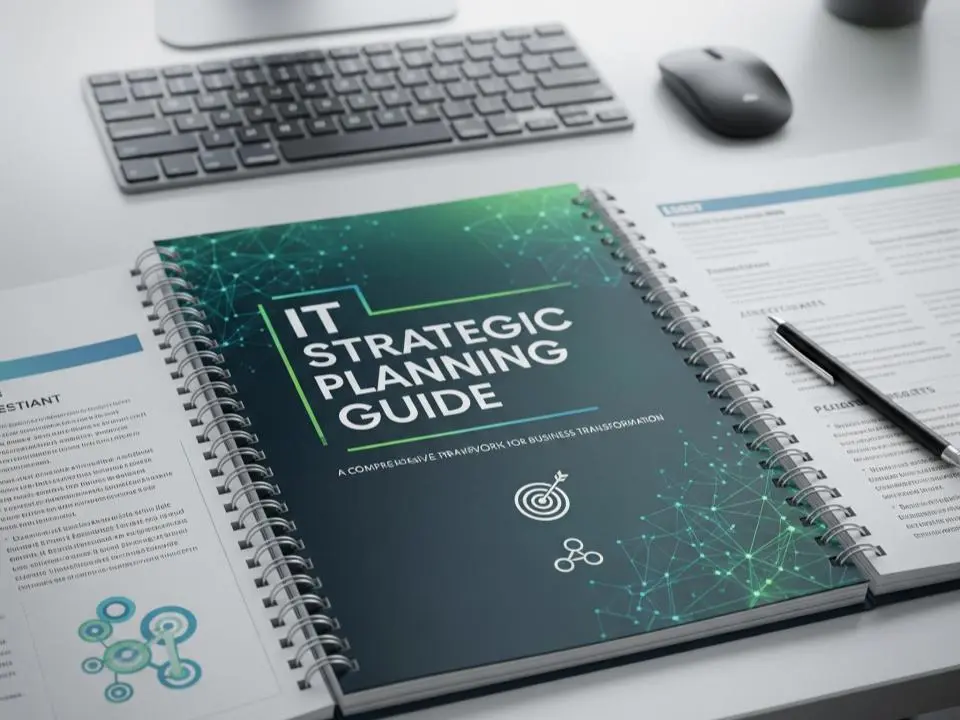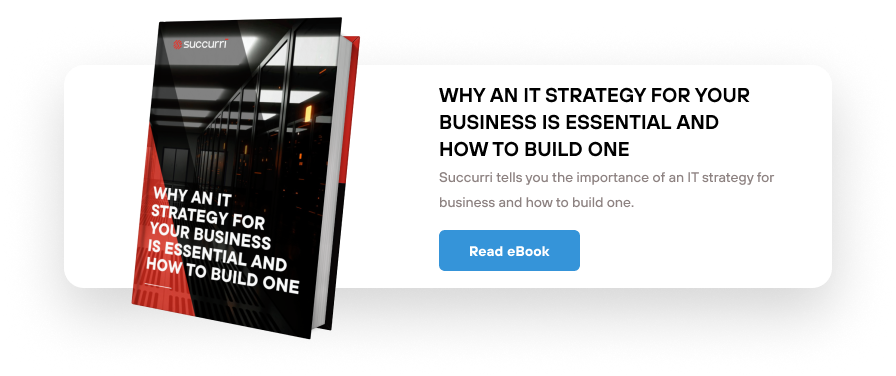Most SMB IT pain comes from ten repeatable mistakes: no plan, weak identity, Shadow IT/SaaS sprawl, untested backups, poor patching, cloud misconfigurations, no Zero Trust roadmap, unmanaged vendor risk, thin training, and no incident playbook.
Anchor your plan to a recognized framework (e.g., NIST CSF), layer in Zero Trust principles, and run a quarterly operating rhythm so controls and evidence stay fresh.
Who Is This Guide For?
Owners and leaders of small to midsize organizations—builders and contractors, healthcare groups, engineering firms, financial services, and tech-enabled SMBs, especially those operating in Seattle/Everett, Phoenix, and Kalispell.

The Top 10 IT Mistakes (and how to fix them)
1) No written IT strategy tied to business goals
Looks like: Ad-hoc purchases, reactive tickets, surprise bills.
Risk: Misaligned spend, downtime, audit failure.
Strategic fix: A one-page IT plan mapped to a standard framework (Govern/Identify/Protect/Detect/Respond/Recover) with owners, timelines, and success metrics.
Quick win: Set quarterly OKRs for reliability, security, and enablement.
2) Treating compliance as a binder, not an operating system
Looks like: Policies exist, but nobody follows them.
Risk: Fines, lost contracts (HIPAA/CMMC/PCI/FTC).
Strategic fix: Map required frameworks to your control set; refresh evidence quarterly.
Quick win: Centralize artifacts in a permissions-controlled Evidence Library.
3) Weak identity: shared accounts, no MFA, no SSO
Looks like: Password reuse and “one admin for everything.”
Risk: Account takeover → ransomware/BEC.
Strategic fix: Enforce MFA everywhere; adopt SSO; least-privilege roles; quarterly access reviews.
Quick win: Retire shared mailboxes; require a password manager.
4) Shadow IT and SaaS sprawl
Looks like: Teams adopting unapproved apps to “move faster.”
Risk: Data leakage, audit gaps, misconfigured sharing.
Strategic fix: Approved-app catalog + simple request path; continuous discovery; conditional access.
Quick win: Publish “safe alternatives” and block high-risk categories.
5) Backups exist… but restores aren’t tested
Looks like: Daily backups, zero restore drills.
Risk: RPO/RTO illusions during ransomware.
Strategic fix: 3-2-1 backups; immutable copies; quarterly restore tests with documented results.
Quick win: Restore one critical system today and time it.
6) Patch and endpoint hygiene on autopilot
Looks like: “We patch monthly (usually).” No EDR telemetry.
Risk: Known-vuln exploits, silent persistence.
Strategic fix: Patch SLAs by criticality; EDR with alerting; monthly exception review.
Quick win: Patch internet-facing assets first; retire out-of-support OS.
7) Cloud defaults left on (M365/Google/AWS)
Looks like: Global sharing, legacy auth, broad admin rights.
Risk: External data exposure at scale.
Strategic fix: Harden security scores; conditional access; device compliance; audit external sharing.
Quick win: Disable legacy protocols; require MFA for admins now.
8) No Zero Trust roadmap
Looks like: Flat networks, “VPN = trusted.”
Risk: Lateral movement after a single compromise.
Strategic fix: Adopt Zero Trust pillars (identity, devices, networks, applications, data, visibility/analytics, automation) and mature iteratively.
Quick win: Micro-segment one high-value system; require device health for access.
9) Vendor/third-party risk unmanaged
Looks like: “They said they’re secure.” No proofs.
Risk: You inherit their breach.
Strategic fix: Tier vendors; collect proofs (SOC 2/BAAs/DPAs); track remediation tasks.
Quick win: Add security language to new and renewing contracts.
10) Little training and no practiced incident response
Looks like: Annual slide deck; nobody knows who to call.
Risk: Slow detection, poor containment, bad comms.
Strategic fix: Onboarding + quarterly micro-training; phishing simulations; annual tabletop; documented comms plan.
Quick win: Add a one-click “Report Phish” button and route to IT/SOC.
“Strategy beats sprawl. Pick a framework, right-size controls, and run the rhythm. Security improves, audits calm down, and the business moves faster.”
— Andrew Eckstrom, vCIO, Succurri
To avoid making these mistakes or minimizing them, we recommend you build a plan.
The following is a framework your business can follow to think about your IT Plan for the year.

IT Planning Framework (One-Page Summary Outline)
Executive Summary (5–7 sentences)
- Business goals: what the organization must achieve this year.
- IT mission: how technology enables those goals.
- Top risks/constraints: security, compliance, budget, talent.
- Strategy pillars: Enablement, Security, Reliability, Data.
- Quarterly rhythm: how progress will be governed and measured.
Current State Snapshot (bullets, not prose)
- People/Process/Tech: key systems, major gaps, tech debt.
- Security posture: identity, device, data, cloud, vendors.
- Compliance context: which frameworks apply and why (e.g., HIPAA/CMMC/PCI/NIST).
- Spend & contracts: major vendors, renewal cliffs.
Guiding Principles
- Business-aligned, outcomes first
- Zero Trust by default (verify explicitly, least privilege, assume breach)
- Cloud-smart & automation-first
- Evidence-ready (audit artifacts always current)
- Simple beats complex (fewer tools, clearer policies)
Strategy Pillars & Objectives
- Enablement: faster employee/partner collaboration, app usability
- Security & Compliance: identity-first controls, data protection, audit readiness
- Reliability & Continuity: resilient infra, tested backups/DR
- Data & Insights: trustworthy data pipeline, basic BI
Each pillar has 2–3 annual objectives with owners and success metrics.
Target Architecture (high-level)
- Identity & Access: SSO + MFA, role-based access, quarterly reviews
- Devices/Endpoints: compliant posture, EDR, patch SLAs
- Network/Cloud: segmented networks, conditional access, hardened M365/Google/AWS
- Data: classification, encryption, DLP, backup/restore tested
- Apps & Integrations: approved SaaS catalog, API standards
- Vendors: tiering, proofs (SOC 2/BAA/DPA), tracked remediations
Compliance Mapping (one table row per framework)
- Framework → Required controls → Where it lives (policy, system) → Evidence owner → Refresh cadence
Roadmap Structure (not tasks)
- Year theme: e.g., “Identity, Visibility, and Backups”
- Quarterly focus:
Q1: Baseline & identity hardening
Q2: Training, vendor governance, policy refresh
Q3: Incident response & DR exercises
Q4: Internal audit, management review, next-year plan
Operating Cadence & Governance
- Monthly: KPI scorecard, risk/exception review
- Quarterly: access reviews, tabletop, evidence refresh, exec update
- Annual: risk assessment, strategy reset, budget alignment
KPI Scorecard (examples)
- Security: MFA coverage %, patch/EDR coverage %, phishing report vs. click rate, backup success % & median restore time
- Reliability: uptime/SLAs, incident MTTR
- Governance: policy acknowledgments %, access review closure %, vendor proofs on file %
- Delivery: roadmap milestone burndown, budget vs. plan

10) Budget & Resourcing (high level)
- Opex/Capex split, top 3 investments, vendor renewals to watch, staffing assumptions (internal, MSP, vCIO/vCISO)
What Succurri brings to Small Businesses
- vCIO leadership: Strategy, roadmap, budgeting, and executive reporting.
- Control mapping: Framework-aligned controls with practical policies.
- Zero Trust rollout: Stepwise maturity that fits SMB realities.
- Compliance support: HIPAA, CMMC, PCI DSS, FTC Safeguards, SOC 2.
Audit-ready evidence: Templates, metrics, and a quarterly operating cadence.
FAQs: IT Strategic Planning for SMBs
What’s the difference between an IT strategy and an IT roadmap?
How often should we refresh the plan?
Do a light quarterly refresh (progress, risks, budget), and a deeper annual reset after your fiscal planning and risk assessment.
Which framework should we use—NIST CSF, ISO 27001, or something else?
For SMBs, NIST CSF is a great backbone (govern/identify/protect/detect/respond/recover). You can map ISO 27001, HIPAA, CMMC, PCI, or SOC 2 requirements onto it.
What’s a sensible SMB IT budget?
Budget to your risk and growth goals—not a generic number. Typical SMBs fund identity/MFA, device health, backups, monitoring, training, and one or two “big rocks” per quarter (e.g., SSO rollout, backup modernization, Zero Trust micro-segmentation).
How do we curb Shadow IT without slowing people down?
Publish an approved app catalog, provide fast request/approval, and run continuous discovery. Pair with SSO/MFA and data access policies (least privilege). Offer safe alternatives so teams can move quickly.
How do we start Zero Trust on a budget?
Begin with identity and device health: enforce MFA, move to SSO, require compliant devices for access, and segment one high-value system. Expand to conditional access and data controls as you mature.
What KPIs should leadership see monthly?
- Security: MFA coverage, phishing report/click rates, patch & EDR coverage, backup success & restore time
- Reliability: uptime/SLA adherence, incident MTTR
- Governance: access review closure, vendor risk status, training completion
- Delivery: roadmap milestone burndown, budget vs. plan
How often should we test backups and restores?
Back up daily, but restore at least quarterly (more often for critical systems). Document RPO/RTO results so you’re not guessing during an incident.
How do we prioritize projects when everything feels urgent?
Use a simple scoring model: risk reduction, business impact, regulatory requirement, effort/cost. Fund a balanced portfolio: quick wins + foundational controls + one strategic initiative each quarter.
vCIO vs. MSP vs. vCISO—who does what?
- vCIO: Business-aligned IT strategy, budgeting, roadmap, vendor governance, exec reporting.
- MSP: Day-to-day operations—help desk, patching, backups (often under vCIO guidance).
- vCISO: Security/compliance depth—risk, controls, audits, incident leadership, Zero Trust.
What belongs in our Incident Response (IR) plan?
Clear roles, severity tiers, playbooks (ransomware/BEC/data loss), comms templates, legal/insurance contacts, and a tabletop schedule. Include a one-click Report Phish path and after-action review.
How should hybrid and field teams be secured?
SSO + MFA, compliant device checks, conditional access, encrypted endpoints, and collaboration controls. For Seattle/Everett construction/engineering, lock down jobsite data sharing; for Phoenix healthcare/finance, emphasize HIPAA/PCI alignment.
What about small teams with limited IT in Kalispell?
Keep it simple: approved apps, SSO/MFA, automated patch/EDR, managed backups with quarterly restores, and a short policy set people actually follow.
What’s a realistic 30-60-90 day plan?
- 30: MFA/SSO baseline, kill shared accounts, create Evidence Library, asset & app inventory.
- 60: Policies, training + phishing sim, vendor due-diligence, close quick wins.
- 90: IR tabletop, restore test, exec scorecard, and next-quarter roadmap lock.
How does compliance fit without taking over the whole plan?
Treat compliance as requirements mapped to your controls, not as separate projects. Refresh evidence quarterly so audits become routine, not emergencies.
Can Succurri support on-site workshops?
Yes—on-site or virtual in Seattle, Everett, Phoenix, and Kalispell. Many clients do an on-site kickoff, then quarterly virtual reviews.
IT Strategy & Risk Assessment
Ready to ditch reactive IT?
Book an IT Strategy & Risk Assessment with Succurri’s vCIO team in Seattle, Everett, Phoenix, or Kalispell. We’ll map your next 90 days and set the cadence that keeps you compliant—and resilient.
About the Author – Andrew Eckstrom, vCIO
Andrew leads Succurri’s vCIO practice, aligning technology plans with business goals for SMBs across construction, healthcare, financial services, engineering, and professional services. He focuses on pragmatic roadmaps, clean execution, and measurable outcomes—so IT reduces risk, boosts productivity, and supports growth.





